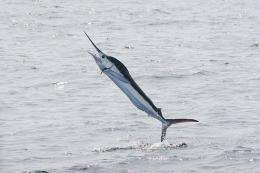Study finds many white marlin are actually look-alike species

They are sleek, elusive predators, slipping through the deep violet of the ocean depths. The challenge of catching white marlin has made them a prime target in fishing tournaments, with the winning catch at last summer's White Marlin Open in Ocean City, Md., reaping a prize of $903,442.
But it turns out many fish identified as white marlin were actually a recently discovered look-alike species called the roundscale spearfish.
A new study by scientists at the federal government, Nova Southeastern University and other institutions has found more than a fourth of the fish caught and identified as white marlin were in fact roundscale spearfish, and their findings could call into question the government's decision to keep the white marlin off the endangered species list.
Although white marlin were never abundant, they used to be routinely caught off the southeast Florida coast, which remains a prime spawning area.
"South Florida used to be a destination for big white marlin," said Bouncer Smith, a Miami Beach charter captain who has caught just two in the past 10 years. "They've been very rare here for years. Seeing one is a rare treat now."
The main reason for the decline: Accidental catch of white marlin on commercial longlines set to catch tuna and swordfish.
The Bush administration two years ago rejected a petition from the Center for Biological Diversity to put the white marlin on the endangered species list, saying numbers were starting to rebound after a series of measures intended to protect them from accidental catch. The administration also removed it from the list of species of concern.
But this study, reported in the journal Endangered Species Research, suggests the government had relied on data that inadvertently inflated the abundance of the species.
The scientists analyzed tissue samples from white marlin caught accidentally by fishing boats and in tournaments. They found that 27 percent of the fish identified as white marlin actually were roundscale spearfish. In other words, there may be a lot fewer white marlin out there than originally thought.
Mahmood Shivji, professor and director of the Guy Harvey Research Institute of Nova Southeastern University, who has made a specialty of marine genetics, said the study suggests the government needs to do a major reassessment of the species' status.
"This is a high enough proportion to muck up previous population assessments of white marlin," Shivji said. "In other words, previous data on white marlin is contaminated by another species, resulting in all past stock assessments of the white marlin -- on which U.S. and international management policy has been based -- uncertain."
Miyoko Sakashita, oceans director for the Center for Biological Diversity, based in Tucson, said the center may make another attempt at getting the white marlin on the endangered species list but will take no immediate action.
Any move to place the white marlin on the endangered species list would face opposition from members of the recreational fishing community. Although they generally support conservation measures such as restrictions on fishing gear to reduce the risk of accidental catch on commercial lines, they oppose blanket protections that could eliminate any fishing, even catch-and-release.
"They are a highly prized game fish," said John Brownlee, editor in chief of the magazine Saltwater Sportsman and a board member of the conservation group The Billfish Foundation. "They're one of the smaller marlin. They are difficult to catch. They are a very sought-after game fish."
David Bernhart, southeast chief of the National Marine Fisheries Service Protect Resources Division, said it's unclear whether any dire conclusions could be drawn from this study.
The latest government review found the stock of white marlin was growing, he said. Even if many of the fish counted were the other species, so long as the assessments were proportional, nothing would alter the fact that the stock is growing, even if the absolute numbers are lower.
"The simplest assumption right now is that everything is proportional," he said. "The previous decline was for combined stocks, and the recent increase was for combined stocks as well."
More information:
(c) 2010, Sun Sentinel.
Distributed by McClatchy-Tribune Information Services.
















